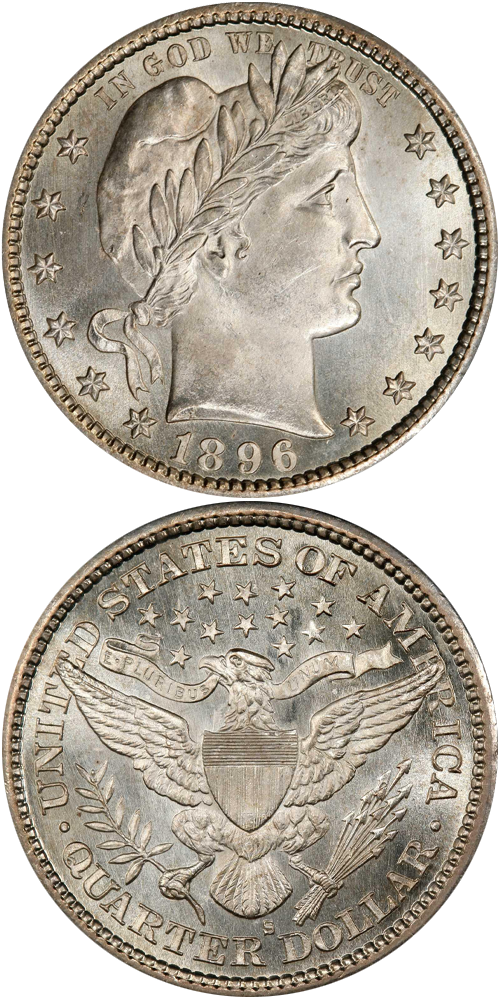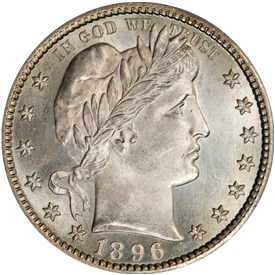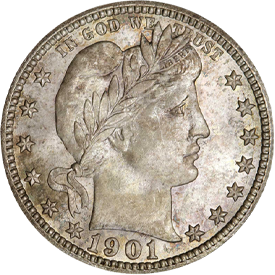Designed by: Charles E. Barber
Issue Dates: 1892-1916
Composition: 90% silver, 10% copper
Diameter: 24.3 mm
Weight: 6.25 grams (96.45 grains)
Edge: Reeded
Business Strike Mintage: 264,670,880
Charles E. Barber's Liberty Head motif, commonly referred to as the "Barber" style, was used on quarter dollars from 1892 through 1916. The obverse motif of Miss Liberty is similar to that found on the dime and half dollar and features her facing to the right, her hair in a Phrygian cap, wearing a laurel wreath, with LIBERTY on a small band above her forehead. Six stars are to the left and seven to the right, IN GOD WE TRUST is above, and the date is below. The reverse is an adaptation of the Great Seal of the United States and depicts a heraldic eagle holding in its talons an olive branch and arrows, although the branch and arrows are transposed from the position used on quarter (and other silver and gold) coinage nearly a century earlier. Above the eagle is a galaxy of 13 stars. UNITED STATES OF AMERICA and QUARTER DOLLAR surround.
For type set purposes, the numismatist will have no trouble finding coins from Good through Fine. Very Fine coins are scarce, and Extremely Fine pieces are quite scarce, at least in the context of more recent issues. AU and Uncirculated pieces are scarcer yet, and superb Uncirculated coins are rare. Proofs were produced of all years from 1892 through 1915 (but not 1916) and are available in proportion to their original mintage.
Further Reading
In 1892 the Barber quarter made its appearance. The obverse design follows that of the Barber dime and half dollar of the same year. The reverse portrays a heraldic eagle (also used on half dollars but not on Barber dimes). The heraldic eagle, an attractive symbol derived from the Great Seal of the United States, was last earlier used on quarters in 1807.
As was the case with dimes and half dollars of this motif, these issues were popularly referred to as Liberty Head quarters or, incorrectly, as "Morgan'' quarters for many years. In a relatively recent era credit has been given to the designer, Charles E. Barber, whose initial B appears on the neck truncation.
Two die varieties exist among 1892 quarters from the three mints (Philadelphia, New Orleans, and San Francisco). Although a number of other characteristics could be cited, the best delineation is the relationship of the eagle's wing to the E in UNITED. On the first type the wing covers only half of the E, and on the second type it covers most of the E. These varieties have been reported in numismatic literature numerous times in the past and are listed, for example, in Scott's Catalogue and Encyclopedia of United States Coins. Still, they have been forgotten by many numismatists. Occasionally someone makes the "discovery" of this variation. In October 1983 a collector wrote to tell me of his "find" in this regard, apparently unaware of earlier listings. Barber quarters were coined more or less continuously at the different mints from 1892 through 1916 inclusive.
There are no super rarities among quarters of this span, but there are several important issues. Primarily among these are three: 1896-S, 1901-S, and 1913-S. These form an interesting study in themselves. Of the 1896-S 188,039 were minted. Of 1901-S, 72,664 were struck, while 40,000 1913-S quarters were made. From all indications one would believe that the rarest dates in order would be 1913-S, the most elusive, then 1901-S, then 1896-S. Reality is different. In worn grades 1901-S is the rarest, 1913-S is second rarest, and 1896-S is less rare. In Uncirculated grade, 1901-S is the rarest, although possibly 1896-S gives it a run for its money and may actually be tied or slightly rarer (however, a 1986 study of the auction appearances of Uncirculated Barber quarters, conducted by Andrew Pollock III, suggests that 1901-S is indeed the rarest), while 1913-S, a piece with the lowest mintage, is several times more plentiful than the first two.
Why is this? The answer is simple. Augustus Heaton's treatise, Mint Marks, first published in the early 1890s, took a number of years to achieve popularity. This is a reflection upon the lack of general interest in the mintmark subject. In 1896, when the San Francisco Mint struck 188,039 quarters, very few people were interested in saving them. I estimate that fewer than two or three dozen were specifically set aside at the time of issue. In comparison to the great demand that was to later develop, this was not very many. In addition, a few dozen others survived by chance – in safe deposit boxes, in attics, and in other locations where coins are sequestered as souvenirs and for other reasons. The total population today in MS-63 or better grades is probably less than a hundred pieces.
By 1901, when the San Francisco Mint struck 72,664 quarters, interest in mintmarks was much more widespread. I estimate that close to 100 1901-S quarters were specifically set aside, with A.C. Gies, a Pittsburgh collector, owning a group of 40 pieces. In addition, some were saved by the public as a matter of chance. It would seem to me that 1901-S is actually a bit more plentiful in Uncirculated grade than 1896-S, but as cataloguers have taken the contrary view, and as 1901-S catalogues for much, much more, my comment in the preceding paragraph is one of uncertainty. In 1913, when the San Francisco Mint struck 40,000 quarters, interest in mintmarks was fairly intense. At least several hundred examples were saved on or around the time of issue.
An article contributed to the "Collectors Clearinghouse" section of Coin World by David Lange, which saw print a few years ago, discussed Barber quarters and noted two obverse types and three reverse types.
The Type I obverse, used from 1892 through 1900, is characterized by the ribbon nearest Miss Liberty's neck ending in a forked tail having a deep slit and narrow fork, while the Type II obverse, used in 1901 and later, features the ribbon ending in a forked tail having a shallow slit and wide forks.
Among reverses, Type A, used only in 1892, has the eagle's left wing tip covering only half of the letter E in UNITED. Reverse Type B has the eagle's wing tip covering most of the letter E in UNITED, and both wing tips extend only as far as the tops of the letters in UNITED STATES OF AMERICA. The 13 stars are more balanced in their spacing between one another than on Type A. The Type B reverse is found on most pieces dated 1892 and for pieces dated from 1893 through 1900. The Type C reverse has both wing tips extending clearly beyond the tops of the letters in UNITED STATES OF AMERICA and was seen by David Lange on all coins examined with the dates 1901 through 1916. However, he did encounter a 1900-S quarter with the Type C reverse.
The entire discussion of varieties is quite interesting. As is the case with Barber dimes, to date little attention has been paid to the minute die variations in the Barber quarter series. It may well be the case that new combinations remain to be discovered. If so, chances are good that these can be obtained on the present market by paying no more than the cost of a regular issue. It is not likely, however, that these varieties, if publicized, will catch on in a big way.
If you refer to my earlier discussion under Barber dimes you will note the scarcity of dimes of this design in higher grades such as Very Fine, Extremely Fine, and AU. The design of quarter dollars has similar characteristics, and pieces which spent only a relatively short time in circulation were quickly worn past the point which all the letters in the word LIBERTY were readable. Thus, while Barber quarters in Good and Very Good grade are seen with some frequency today, Fine, Very Fine, Extremely Fine, and AU coins are much, much more elusive than most people think. It is probably the case that an effort to put together a matched set of Extremely Fine Barber quarters, even if one were to exclude 1896-S, 1901-S, 1913-S, would involve a period of many months, if indeed it could be accomplished in a year! This statement will seem incredible to anyone who simply glances at catalogue listings, for most of these issues are quite inexpensive – and rare coins are supposed to be the same as expensive coins. Or are they?
As is the case with worn Liberty Seated quarters, I have never seen an investment newsletter, investment writer, or anyone else recommend Very Fine or Extremely Fine Barber quarters, simply because no one has a vested interest in these. If a real estate writer issues a detailed report on a condominium project, a downtown office building, or whatever, you can reasonably bet that there is some money to be made when the writer is involved with the sale of such things. So it is with nearly all coin investment writing I have seen over the years. A great amount of attention paid to a certain area in print in an investment newsletter usually means that such pieces are for sale. There are, to be sure, some exceptions – but not many.








